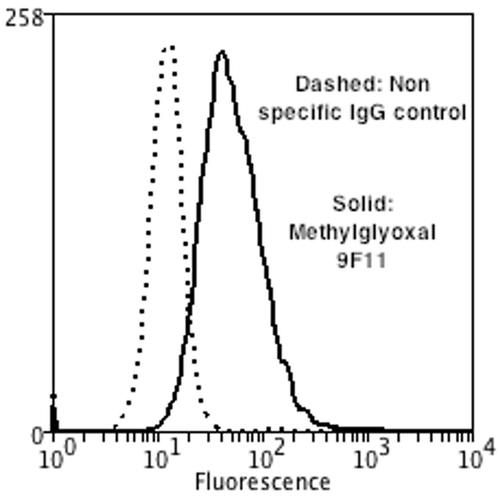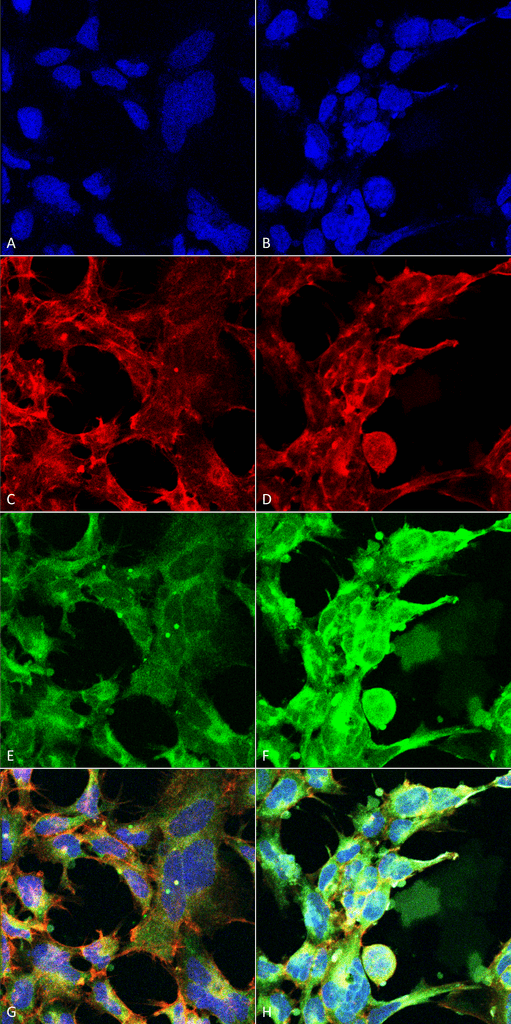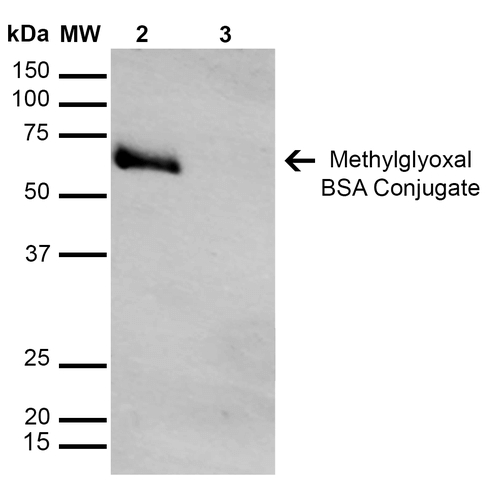Anti-Methylglyoxal Mouse Monoclonal Antibody (56618)
$441.00
| Host | Quantity | Applications | Species Reactivity | Data Sheet | |
|---|---|---|---|---|---|
| Mouse | 100 ug | WB,ICC/IF,FACS,FCM,ELISA | Species Independent |  |
SKU: 56618
Categories: Antibody Products, Heat Shock and Stress Protein Antibodies, Products
Overview
Product Name Anti-Methylglyoxal Mouse Monoclonal Antibody (56618)
Description Anti-Methylglyoxal Mouse Monoclonal Antibody
Target Methylglyoxal
Species Reactivity Species Independent
Applications WB,ICC/IF,FACS,FCM,ELISA
Host Mouse
Clonality Monoclonal
Clone ID 9F11
Isotype IgG1
Immunogen Synthetic Methylglyoxal modified Keyhole Limpet Hemocyanin (KLH).
Properties
Form Liquid
Concentration 1 mg/mL
Formulation PBS pH 7.4, 50% glycerol, 0.09% Sodium azide
Buffer Formulation Phosphate Buffered Saline
Buffer pH pH 7.4
Buffer Anti-Microbial 0.09% Sodium azide
Buffer Cryopreservative 50% glycerol
Format Purified
Purification Protein G Purified
Background Lipid peroxidation occurs when oxidizing agents attack carbon-carbon double bonds found in unsaturated lipids. In addition to membrane degradation, oxidation end-products have been found to damage cell viability through their mutagenic and toxic properties. These downstream functional consequences facilitate the development of disease and premature aging. Methylglyoxal is an alpha-oxoaldehyde generated from lipid peroxidation that reacts with proteins to form adducts(1). It reacts with free amino acids and protein residues to generate advanced glycation endproducts (AGEs) and crosslinks DNA polymerase and substrate DNA to severely inhibit DNA replication (2).
Specificity Information
Specificity Specific for Methylglyoxal modified proteins. Does not detect free Methylglyoxal. Does not cross-react with Acrolein, Hexanoyl Lysine, Malondialdeyhde, 4-Hydroxy-2-hexenal, 4-Hydroxy nonenal, or Crotonaldehyde modified proteins.
Target Name Methylglyoxal
Target ID Methylglyoxal
Alternative Names Methylglyoxal, 2-Oxopropanal, 2 oxo propanal, MG, Pyruvaldehyde, Methylglyoxal (MG), MG-modified protein
CAS Number 78-98-8
PubChem ID 880
Research Areas Cancer | Oxidative Stress | Lipid peroxidation
Application Images




Description Flow Cytometry analysis using Mouse Anti-Methylglyoxal Monoclonal Antibody, Clone 9F11 . Tissue: Neuroblastoma cells (SH-SY5Y). Species: Human. Fixation: 90% Methanol. Primary Antibody: Mouse Anti-Methylglyoxal Monoclonal Antibody at 1:50 for 30 min on ice. Secondary Antibody: Goat Anti-Mouse: PE at 1:100 for 20 min at RT. Isotype Control: Non Specific IgG. Cells were subject to oxidative stress by treating with 250 µM H2O2 for 24 hours.

Description Immunocytochemistry/Immunofluorescence analysis using Mouse Anti-Methylglyoxal Monoclonal Antibody, Clone 9F11 . Tissue: Embryonic kidney epithelial cell line (HEK293). Species: Human. Fixation: 5% Formaldehyde for 5 min. Primary Antibody: Mouse Anti-Methylglyoxal Monoclonal Antibody at 1:50 for 30-60 min at RT. Secondary Antibody: Goat Anti-Mouse Alexa Fluor 488 at 1:1500 for 30-60 min at RT. Counterstain: Phalloidin Alexa Fluor 633 F-Actin stain; DAPI (blue) nuclear stain at 1:250, 1:50000 for 30-60 min at RT. Magnification: 20X (2X Zoom). (A,C,E,G) - Untreated. (B,D,F,H) - Cells cultured overnight with 50 µM H2O2. (A,B) DAPI (blue) nuclear stain. (C,D) Phalloidin Alexa Fluor 633 F-Actin stain. (E,F) Methylglyoxal Antibody. (G,H) Composite. Courtesy of: Dr. Robert Burke, University of Victoria.

Description Western Blot analysis of Methylglyoxal-BSA Conjugate showing detection of 67 kDa Methylglyoxal protein using Mouse Anti-Methylglyoxal Monoclonal Antibody, Clone 9F11 . Lane 1: Molecular Weight Ladder (MW). Lane 2: Methylglyoxal-BSA. Lane 3: BSA. Load: 0.5 µg. Block: 5% Skim Milk in TBST. Primary Antibody: Mouse Anti-Methylglyoxal Monoclonal Antibody at 1:1000 for 2 hours at RT. Secondary Antibody: Goat Anti-Mouse IgG: HRP at 1:1000 for 60 min at RT. Color Development: ECL solution for 5 min in RT. Predicted/Observed Size: 67 kDa.
Handling
Storage This antibody is stable for at least one (1) year at -20°C. Avoid multiple freeze-thaw cycles.
Dilution Instructions Dilute in PBS or medium which is identical to that used in the assay system.
Application Instructions WB (1:1000); ICC/IF (1:50); FACS (1:50); FCM (1:50); ELISA (1:1000); optimal dilutions for assays should be determined by the user.
References & Data Sheet
Data Sheet  Download PDF Data Sheet
Download PDF Data Sheet
 Download PDF Data Sheet
Download PDF Data Sheet






